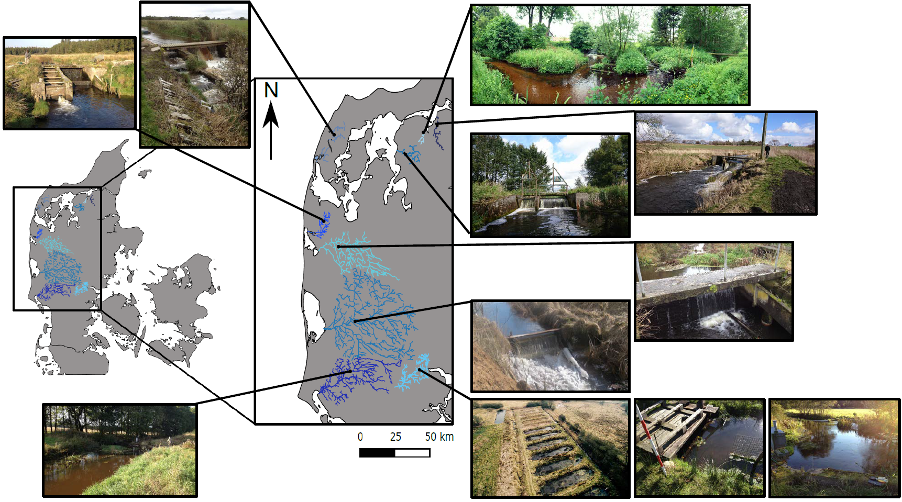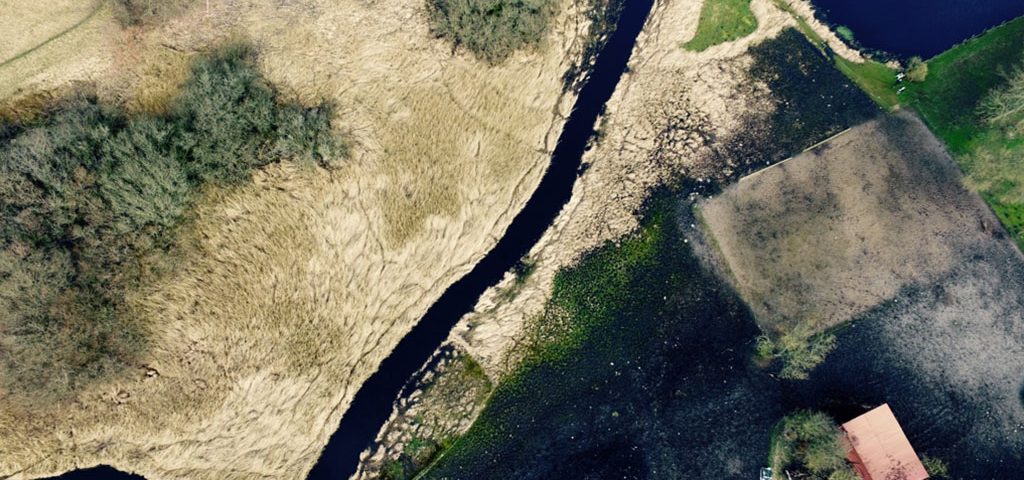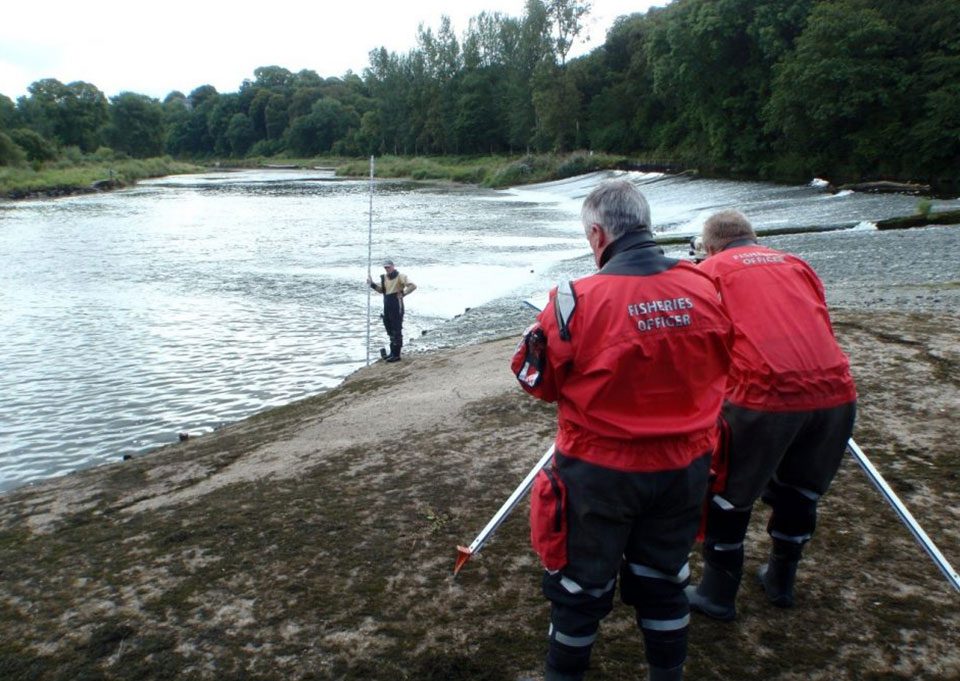Case Study Number: 7
Dam name: Various (12 in Denmark, 10 in the UK)
River name: Various
Built date: Various
AMBER TOOLS: Habitat surveys (D3.1)
THE NEED
Small barriers, such as weirs and water gauging stations, are highly abundant worldwide, though perhaps especially in Europe. Smaller barriers are often deemed to have fewer impacts on fish populations though their abundance and cumulative impact makes for widespread effects. Too often, these barriers are left unnoticed and simply grow old, unsafe and obsolete whilst still limiting fish movements. We would argue that their removal provides a cost-effective way of reinstating connectivity and promoting sustainability of freshwater ecosystems. Small barriers are, by their nature, most common on smaller, low stream order watercourses and the extent of their effects on biota depends primarily on their effects on habitat and connectivity.
Problems
- High barrier density
- High number of obsolete barriers
- Increased river fragmentation with reduction in natural habitat

Site locations in Denmark
WHAT WE DID
In Denmark, A total of 12 weirs were removed across the Jutland peninsula during the lifetime of AMBER. Changes in habitat (including depth, substrate and flow) and fish density were monitored in the 50m directly upstream of the barriers and a total of 311km of river was reconnected.Fish density was evaluated at all sites, once prior to removal, and twice after removal except for Clasonsborg which was added to the study later one, and thus only has one set of post-removal measurements.
Rivers and streams across the UK contain numerous old weirs, culverts and barriers which were built for historic reasons such as powering mills, raising riverbed levels or redirecting water courses. Recent estimates suggest that in England there are 0.75 barriers river-km-1 and across Great Britain only 1% of rivers are free of artificial barriers. During the lifetime of AMBER there has been increased attention and efforts focussed on the removal of low head barriers often initiated and coordinated by local rivers trusts and this case study focuses on the removal of such barriers at 10 sites across northern England.
Tools
- Habitat surveys (D3.1)

Site locations in northern England
NOW WHAT?
The short-term impacts of barrier removal on the fish community at the Danish and northern English sites studied were quite different. Whilst a rapid response of the fish community to barrier removal was observed at the Danish sites, the impact of barrier removal at sites in northern England was variable with no uniform pattern across all sites. There were several differences in the sites studied in Denmark and England which appear to have contributed to the observed differences in response. The barriers removed in Denmark were larger (mean height of weir 1.53m) compared to the English sites (mean 0.49m) with a longer ponded length (Mean length of ponded zone: Denmark 931m; Northern England 47m) and lower gradient. At the one site studied in northern England that did have a barrier >1m and a large ponded zone a clear response of the fish community was recorded following barrier removal.

Gelstrup Dambrug before and after removal.
WHO WAS INVOLVED?
AMBER partner Technical University of Denmark (DTU)
FURTHER READING
References
Backiel, T. 1985. Fall of migratory fish populations and changes in commercial fisheries in impounded rivers in Poland - Habitat Modification and Freshwater Fisheries: 28-41.
Birnie-Gauvin, K., Aarestrup, K., Riis, T. M., Jepsen, N. & Koed, A. 2017. Shining a light on the loss of rheophilic fish habitat in lowland rivers as a forgotten consequence of barriers, and its implications for management. Aquatic Conservation: Marine and Freshwater Ecosystems, 27: 1345-1349.
Birnie-Gauvin, K., Candee, M. M., Baktoft, H., Larsen, M. H., Koed, A. & Aarestrup, K. 2018. River connectivity reestablished: effects and implications of six weir removals on brown trout smolt migration. River Research and Applications, 34, 548-554. doi: 10.1002/rra.3271.
Birnie-Gauvin, K., Larsen, M. H., Nielsen, J. & Aarestrup, K. 2017b. 30 years of data reveal a dramatic increase in abundance of brown trout following the removal of a small hydrodam. Journal of Environmental Management, 204, 467-471. doi: 10.1016/j.jenvman.2017.09.022.
Birnie-Gauvin, K., Tummers, J.S., Lucas, M.C. & Aarestrup, K. 2017. Adaptive management in the context of barriers in European freshwater ecosystems. Journal of Environmental Management 204: 436-441.
Carle, F.L. & Strub, M.R. 1978. A new method for estimating population size from removal data. Biometrics 34: 621-630.
Cooke, S. J., Bunt, C. M., Hamilton, S. J., Jennings, C. A., Pearson, M. P., Cooperman, M. S., & Markle, D. F. 2005. Threats, conservation strategies, and prognosis for suckers (Catostomidae) in North America: insights from regional case studies of a diverse family of non-game fishes. Biological Conservation, 121: 317-331.
Garcia de Leaniz, C., Belletti, B., Bizzi, S., Segura, G., Borger, L., Jones, J.,the AMBER consortium. 2018. The importance of having a good database for restoring river connectivity: The AMBER barrier atlas in Europe. In: Brink, K., Gough, P., Royte, J., Schollema, P.P., Wanningen, H. Eds. From Sea to Source 2.0. Protection and Restoration of Fish Migration in Rivers Worldwide. World Fish Migration Foundation, Groningen, 142–145.
Lockwood, R. N. & Schneider, J. C. 2000. Stream fish population estimates by markand-recapture and depletion methods. Chapter 7 in Manual of fisheries survey methods II: with periodic updates. Michigan Department of Natural Resources, Fisheries Special Report 25, Ann Arbor.
Lucas, M. C. & Baras, E. 2001. Migration of Freshwater Fishes. Blackwell Science, Oxford, UK.
Jones, J., Börger,L., Tummers, J., Jones, P., Lucas, M., Kerr,J., Kemp, P. et al. 2019. A comprehensive assessment of stream fragmentation in Great Britain. Science of the total environment 673: 756-762.
Kemp, P.S. & O'Hanley, J.R. 2010. Procedures for evaluating and prioritising the removal of fish passage barriers: a synthesis. Fisheries Management and Ecology 17: 297-322.
Tummers, J.S., Hudson, S. & Lucas, M.C. 2016. Evaluating the effectiveness of restoring longitudinal connectivity for stream fish communities: towards a more holistic approach. Science of the Total Environment 569: 850-860.




